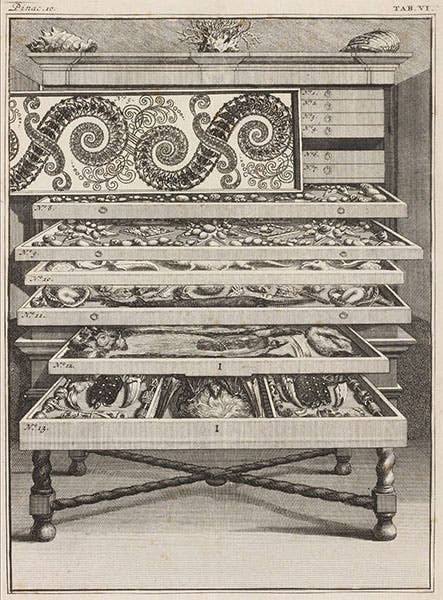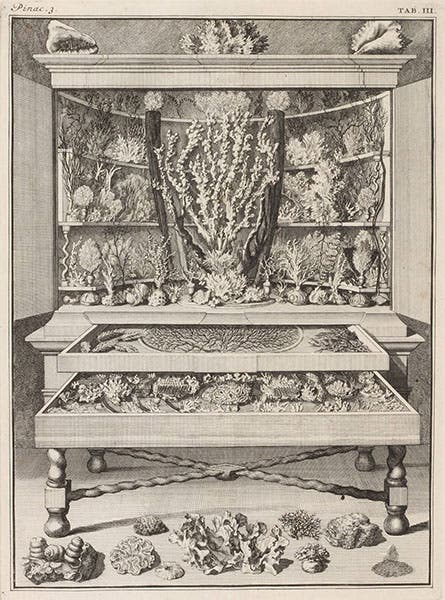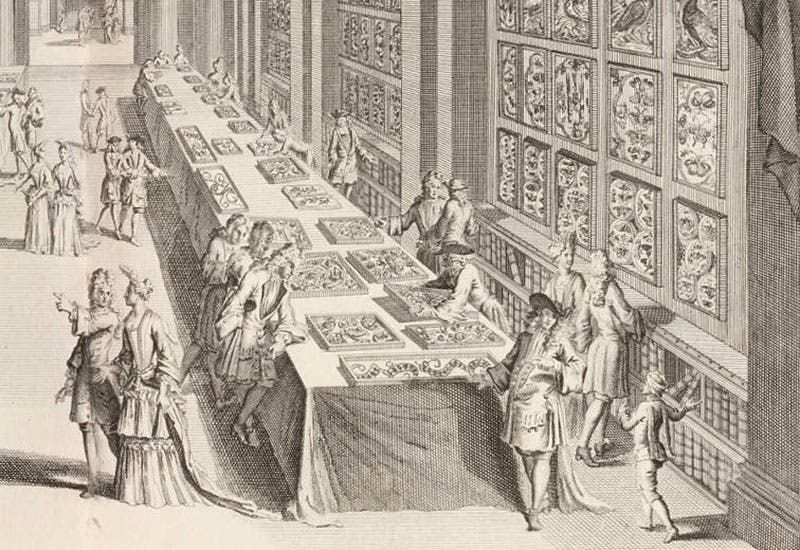Scientist of the Day - Levinus Vincent
Levinus Vincent, a Dutch cloth merchant and collector, died Nov. 8, 1727, at the age of about 69; his birth date is not recorded. His trading in exotic fabrics apparently made him rich, for he and his wife expended large sums to amass a collection of exotica which they put on display in their home in Amsterdam. There had been many private museums assembled before, such as that of Ole Worm in Copenhagen, but Vincent's differed in the attention given to display. Most of the objects collected were small, and they were arranged in 12 large cabinets. containing hundreds of drawers and shelves. A drawer of butterflies might show dozens of butterflies assembled into some pleasing pattern that had nothing to do with nature – that in many cases looked more like a rich silk brocade, strangely enough (first image). It is hard to imagine the number of hours that went into arranging such drawers, or sorting specimens in spirits on shelves, to make the most pleasing arrangement.
IN 1705, Vincent published a description and catalog of his museum, called Wondertooneel der Nature (Theatre of the Marvels of Nature). Fourteen years later, an abridgement was issued, with text in Latin and French, but containing all of the original 9 plates. This is the volume we have in our Library. It has two title pages – the Latin one begins Elenchus tabularum (List of plates), which provides the usual short title for the work, but the French title is more indicative of the book’s contents, which we translate as “Abridged description of the plates that represent the cabinet of curiosities contained in the Theatre of the Marvels of Nature of Levinus Vincent (1719)”.
The plates include an allegorical frontispiece (signed by the great Dutch artist Romeyn de Hooghe), a double-page and perhaps fanciful view of the museum, and 7 individual plates that depict the 12 cabinets. The plates are as meticulously arranged as the specimens in the drawers. For example, one plate shows cabinet 10, with some drawers partially opened to show their contents, and one removed to show an intricate lacework of butterflies and insects (second and third images).
Another depicts and elaborates tableau of corals (fourth image).
And yet another shows two cabinets that contains fossils; we show a detail of the displayed specimens at the bottom (fifth image)
We also show a detail of the double-page plate that depicts the museum open to visitors; it is no doubt exaggerated, but still captures the feeling of awe and amazement that’s visitors felt upon viewing Vincent’s collection (sixth image). You may see the entire engraving here.
The frontispiece is probably a more accurate view of Vincent’s cabinets on display in his home (seventh image). It attempts to be allegorical by including four personifications below (eighth image).
Romeyn de Hooghe has used one traditional personification (that of the multi-breasted Cybele/Nature), but the other three are inventions of his own, perhaps representing Collecting, Exploring, and Medicine. The four figures sit amidst drawers from Vincent’s cabinets, and specimen bottles from his shelves, suggesting that it requires explorers and collectors to amass a collection like this, which is then so useful for unveiling Nature and improving the knowledge of the physician. Dr. William B. Ashworth, Jr., Consultant for the History of Science, Linda Hall Library and Associate Professor emeritus, Department of History, University of Missouri-Kansas City. Comments or corrections are welcome; please direct to ashworthw@umkc.edu.













